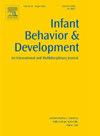Infant sensitivity to mismatches between same/other-race faces and native/non-native speech
IF 2
3区 心理学
Q3 PSYCHOLOGY, DEVELOPMENTAL
引用次数: 0
Abstract
Perceptual narrowing typically occurs around 6 months of age, and drastically changes an infant’s perception of stimuli such as faces or spoken language according to the frequency with which the infant encounters them. It has already been well established that perceptual narrowing improves the sensitivity of infants to frequently encountered stimuli such as same-race faces and their native language while reducing their sensitivity to other-race faces and non-native languages. However, the effect of perceptual narrowing on the combined perception of face and language stimuli is not well understood. Therefore, to investigate the changes in the sensitivity of infants to matches and mismatches between faces and speech which might occur in the course of perceptual narrowing, we tested 3- and 9-month-old German infants using German faces and German spoken sentences which would be familiar to the infants, as well as completely unfamiliar Chinese faces and French spoken sentences. The infants were tested using an intermodal association paradigm, whereby each infant saw sequences of German or Chinese faces, interspersed with German or French spoken sentences. We analyzed the total looking time of infants in conditions where the faces and spoken sentences were congruent (either both familiar, or both unfamiliar), versus incongruent conditions where only the faces or only the sentences were familiar. We found that while the 9-month-olds looked for similar durations in congruent versus incongruent conditions, the 3-month-olds looked significantly longer during congruent conditions versus incongruent conditions, indicating a greater attentiveness to face-speech matches and mismatches prior to the onset of perceptual narrowing.
婴儿对同种/异种面孔与母语/非母语语音不匹配的敏感性
感知缩小通常发生在婴儿 6 个月大左右,它会根据婴儿遇到面孔或口头语言等刺激物的频率,极大地改变婴儿对这些刺激物的感知。知觉缩小会提高婴儿对经常遇到的刺激物(如同种族面孔和母语)的敏感度,同时降低他们对其他种族面孔和非母语的敏感度,这一点已经得到证实。然而,知觉缩小对面孔和语言刺激的综合知觉的影响却不甚了解。因此,为了研究在知觉缩小过程中婴儿对人脸和语言之间的匹配和不匹配的敏感性可能发生的变化,我们使用婴儿熟悉的德国人脸和德语口语句子以及完全不熟悉的中国人脸和法语口语句子对 3 个月和 9 个月大的德国婴儿进行了测试。我们采用了一种跨模态联想范式对婴儿进行了测试,在这种范式中,每个婴儿看到的都是德国或中国面孔序列,其中穿插着德国或法国口语句子。我们分析了在人脸和口语句子一致(要么都熟悉,要么都不熟悉)与不一致(只有人脸或只有句子是熟悉的)条件下婴儿的总观察时间。我们发现,虽然 9 个月大的婴儿在一致和不一致条件下的注视时间相近,但 3 个月大的婴儿在一致条件下的注视时间明显长于不一致条件下,这表明在知觉缩小开始之前,婴儿对面孔-语音匹配和不匹配的注视时间更长。
本文章由计算机程序翻译,如有差异,请以英文原文为准。
求助全文
约1分钟内获得全文
求助全文
来源期刊

Infant Behavior & Development
PSYCHOLOGY, DEVELOPMENTAL-
CiteScore
4.10
自引率
4.80%
发文量
94
期刊介绍:
Infant Behavior & Development publishes empirical (fundamental and clinical), theoretical, methodological and review papers. Brief reports dealing with behavioral development during infancy (up to 3 years) will also be considered. Papers of an inter- and multidisciplinary nature, for example neuroscience, non-linear dynamics and modelling approaches, are particularly encouraged. Areas covered by the journal include cognitive development, emotional development, perception, perception-action coupling, motor development and socialisation.
 求助内容:
求助内容: 应助结果提醒方式:
应助结果提醒方式:


